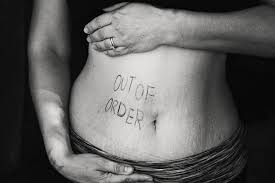Did you know, 100% of women will develop diastasis recti by the 3rd trimester of pregnancy? Whether or not your abdominal gap completely closes during the postpartum healing period depends on how severe your diastasis recti is. There are classic diastasis recti symptoms you need to be aware of so you can start your journey to healing faster. In this article, I will walk you through understanding the various diastasis recti symptoms and show you some great remedies to help you cope with, and even completely heal from them. Let’s get to it!
How To Do A Self-Check
Perform this self-check to see if you have diastasis recti:
- Lie on your back, legs bent, feet flat on the floor.
- Raise your shoulders up off the floor slightly, supporting your head with one hand, and look down at your belly.
- Move your other hand above and below your bellybutton, and all along your midline ab muscles. See if you can fit any fingers in the gaps between your muscles.
- If you feel a gap, or separation of one to two finger lengths, you likely have a moderate case of diastasis recti. After a few weeks postpartum, the gap will start to narrow as your muscles regain strength.
Types Of Diastasis Recti
Did you know the ab muscles can separate in different locations? Depending on where the separation is, determins what “type” of DR you have. The location of the separation of abdominal muscles will look different from the outside. What does yours look like? Use the diagram below to see.
P.S. Don’t worry, all types of diastasis recti can be healed through these quality programs!

Symptoms Of Diastasis Recti
Lower Back Pain

One of the jobs of the abdominal muscles is to offer support for the lower back. When that support is gone, it puts extra strain on your back! Ever done an exercise, and the instructor reminded you to keep your core engaged (or tight) to prevent back injury? Now you know why! With DR, your lower back is straining extra hard to support your weight. If not corrected, this can lead to slipped discs or hernias.
What to do about it
There are wonderful at-home exercises you can do to strengthen your core. The programs I will recommend to you are clinically proven to bring the ab separation together and strengthen your core! What does this mean? No more back pain! It also means a host of other benefits for your body. Ready to start your journey to healing? Click the button below to see which programs are the absolute best to restore your core and heal your DR!
Constipation
Another unwanted symptoms of diastasis recti is constipation. Why does this happen? Due to the muscle weakness in the front of the abdomen, there is not a lot of support for the organs behind those muscles. This includes the intestines. This means that without the muscles to help support the intestines, what enters our gutt tends to sit more and move less.
We all know that walking and motion assists with bowel movements. Why is this? As the muscles surrounding the abdomen move, they assist in moving substance through the bowels. Due to DR, the efficiency of this process is weakened, leading to constipation.
Constipation may feel like:
- bloating
- pain in the belly
- moodiness
- straining/difficulty defecating
- needing to sit on the toilet for long periods of time
- lumpy/hard stool
What to do about it
During and after pregnancy, I struggled a lot with constipation. What really helped me stay regular was eating a healthy diet and taking a laxative. I found a lot of relief taking MeraLAX. My OB-GYN suggested taking MeraLAX to me during pregnancy. She told me it does not get absorbed by the body, so it is safe for you and for the baby.
Making sure you are eating foods high in fiber will also help with your constipation. However, if you don’t want to increase your intake of fiber by changing your diet, you can take a fiber supplement such as Benefiber.
Learn more about remedies for severe constipation by reading my article. Or click the button below!
Poor Posture

Did you know that one of the diastasis recti symptoms is poor posture? Your abdominal muscles may be more important than you think. As mentioned before, your ab muscles offer support for your lower back as well as for your core. When this support is gone, it is difficult to hold good posture for too long. Even for just a couple seconds. With diastasis recti, you unconsciously begin to slouch. Your shoulders round forward and your tummy pooches out. After a few seconds, you may think, “Man! I’m slouching again! Why is sitting up straight so hard?” Strong abdominal muscles are important (and necessary!) for keeping good posture.
Poor posture can lead to further pain in the body such as stiff muscles, headaches, back problems (including possible slipped discs), and more constipation. What can you do about this diastasis recti symptom?
Do something today that your future self will thank you for. – Sean Patrick Flanery
I love this quote because it inspires proactivity! Sean Patrick Flanery also encourages us to do something today that may be difficult in order to benefit our lives in the future.
What to do about it?
How important is your core strength to you? Do you care about your back and posture? Do you want to prevent slipped discs, hernias, pelvic floor issues, and diastasis-recti – related problems? Then consider what steps you need to take TODAY in order to prevent these problems from getting worse in the future.
Do you need to start an exercise program or see a therapist? The choice is yours! Be sure to check out these at-home programs that have helped hundreds of women restore their core!
Pelvic Floor Weakness
Another diastasis recti symptom is weakness in the pelvic floor. What is the pelvic floor? For a long time, I was confused about what this phrase meant, exactly. I have heard it explained as the muscles “beneath” you, or the muscles you “sit” on, but it’s much more than that. To put it simply, it is the muscles that make up the vagina! I guess people are afraid of using the “V” word, but there is nothing dirty about that word. It is a part of us, and we need to understand it so we can help heal and strengthen it. Below is a diagram explaining the outer muscles of the vagina.

When we say that diastasis recti causes pelvic floor issues, what type of issues are we talking about? Your pelvic floor helps support your body’s weight (including the weight of the baby during pregnancy), helps with controlled urination and defecation, and help support healthy sexual function of the vagina and penis. So when the pelvic floor is weak or not working properly, it affects all these areas of life!
Health issues associated with a weak pelvic floor:
- Leaking urine throughout normal daily activities
- Problems defecating
- Hernia issues
- Lack of satisfaction in intercourse for either partner
What Can You Do About It?
When it comes to strengthening the vagina, you need to do much more than just Kegal exercises. I took a couple different courses to try and strengthen my pelvic floor and nothing brought the results I was looking for. Yes, my core showed some improvement, but my pelvic floor was not improving at all! I still leaked urine and intercourse was so boring.
There is only one program I can truly say has has started to bring real change and strength to my pelvic floor, and I am SO excited to share it with you!
It is called Strong Core & Pelvic Floor by Sharny and Julius. This woman’s testimony is incredible and has helped thousands of women not only stop leaking 100% but also completely close their diastasis recti gap, significantly improve the strength of the vagina (which helps with sex!), and even get rid of hemorrhoids!

Summary
Diastasis recti symptoms are not fun, and if they go left untreated they can lead to further health risks later in life. These include slipped discs and abdominal hernias. Those with diastasis recti already struggle with constipation, poor posture and a possibly defeated self-image.
The good news is, you don’t have to stay here. You absolutely can get your abs together, stop unwanted urine leaks, improve your sex life, get your self-confidence back, and so much more! Be sure to check out the at-home programs I recommend, like Strong Core & Pelvic Floor, which has helped thousands of women get their strength and lives back!
You can do this, Mama! We believe in you!
Leave A Comment Below!

What did you learn from this article? Share your thoughts with us in the comments below! We always love hearing from our Mama audience!
Other Related Articles
If you enjoyed this article, check out these other articles related to diastasis recti!
Best Corrective Exercises For Diastasis Recti
Homeopathic Remedies For Back Pain
How To Prevent Diastasis Recti
Severe Constipation During Pregnancy Remedies
Who Can Develop Diastasis Recti?
